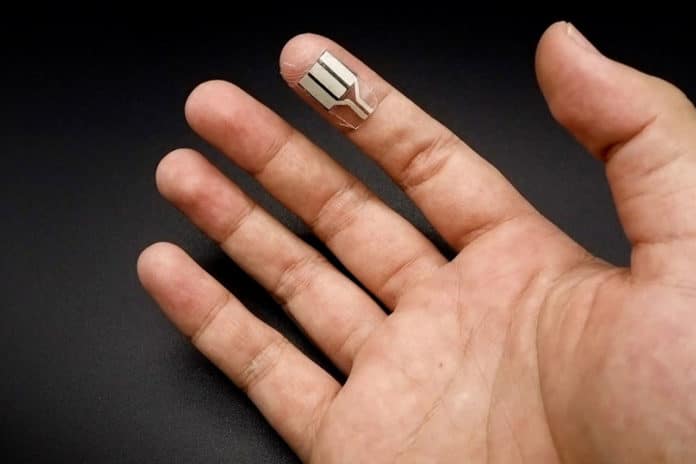Engineers at the University of California San Diego developed a new wearable device that turns the touch of a finger into a source of power for small electronics and sensors. The device is a thin, flexible strip worn on a fingertip and generates small amounts of electricity when a person’s finger sweats or presses on it.
More interestingly, this sweat-powered device is capable of generating power even when the wearer is asleep or sitting still. This could open up some very interesting possibilities in the wearable space, as the researchers have now figured out how to harness the energy that can be extracted from human sweat even when a person is not moving.
“Unlike other sweat-powered wearables, this one requires no exercise, no physical input from the wearer in order to be useful,” said the researcher Lu Yin. “This work is a step forward to making wearables more practical, convenient, and accessible for the everyday person.“
The sweat-powered device consists of a thin, flexible strip that can be wrapped around the fingertip like a Band-Aid. It has a padding of carbon foam electrodes that absorb sweat and use embedded enzymes to trigger chemical reactions between lactate and oxygen molecules within it to generate electricity. There’s also a chip underneath the electrodes made of piezoelectric material that generates more energy when pressed. The electrical energy is then stored in a small capacitor and discharged into the devices when required.
The device derives most of its power from sweat produced by the fingertips, which are one of the sweatiest spots on the body; each one is packed with over a thousand sweat glands and is a 24-hour factory of perspiration.
In an experiment, subjects wore the device on one fingertip during 10 hours of sleep, which generated almost 400 millijoules of energy – enough to power an electronic wristwatch for 24 hours. Also, from one hour of casual typing and clicking on a mouse, the device collected almost 30 millijoules.
“Compare this to a device that harvests energy as you exercise,” explained Yin. “When you are running, you are investing hundreds of joules of energy only for the device to generate millijoules of energy. In that case, your energy return on investment is very low. But with this device, your return is very high. When you are sleeping, you are putting in no work. Even with a single finger press, you are only investing about half a millijoule.“
In other experiments, the team used their novel energy harvester to power chemical sensors and displays, including the vitamin C sensor and sodium sensor. They are now working to improve the fingertip-powered wearable to make it both more efficient and durable and hope to combine it with other energy harvesters to create a new generation of self-powered wearable systems.
“Our goal is to make this a practical device,” said the study co-author Yin. “We want to show that this is not just another cool thing that can generate a small amount of energy, and then that’s it – we can actually use the energy to power useful electronics such as sensors.“
